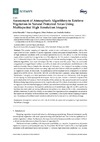Please use this identifier to cite or link to this item:
https://accedacris.ulpgc.es/handle/10553/42112
| DC Field | Value | Language |
|---|---|---|
| dc.contributor.author | Marcello, Javier | en_US |
| dc.contributor.author | Eugenio González, Francisco | en_US |
| dc.contributor.author | Perdomo, Ulises | en_US |
| dc.contributor.author | Medina, Anabella | en_US |
| dc.date.accessioned | 2018-10-10T08:31:22Z | - |
| dc.date.available | 2018-10-10T08:31:22Z | - |
| dc.date.issued | 2016 | en_US |
| dc.identifier.issn | 1424-8220 | en_US |
| dc.identifier.other | WoS | - |
| dc.identifier.uri | https://accedacris.ulpgc.es/handle/10553/42112 | - |
| dc.description.abstract | The precise mapping of vegetation covers in semi-arid areas is a complex task as this type of environment consists of sparse vegetation mainly composed of small shrubs. The launch of high resolution satellites, with additional spectral bands and the ability to alter the viewing angle, offers a useful technology to focus on this objective. In this context, atmospheric correction is a fundamental step in the pre-processing of such remote sensing imagery and, consequently, different algorithms have been developed for this purpose over the years. They are commonly categorized as imaged-based methods as well as in more advanced physical models based on the radiative transfer theory. Despite the relevance of this topic, a few comparative studies covering several methods have been carried out using high resolution data or which are specifically applied to vegetation covers. In this work, the performance of five representative atmospheric correction algorithms (DOS, QUAC, FLAASH, ATCOR and 6S) has been assessed, using high resolution Worldview-2 imagery and field spectroradiometer data collected simultaneously, with the goal of identifying the most appropriate techniques. The study also included a detailed analysis of the parameterization influence on the final results of the correction, the aerosol model and its optical thickness being important parameters to be properly adjusted. The effects of corrections were studied in vegetation and soil sites belonging to different protected semi-arid ecosystems (high mountain and coastal areas). In summary, the superior performance of model-based algorithms, 6S in particular, has been demonstrated, achieving reflectance estimations very close to the in-situ measurements (RMSE of between 2% and 3%). Finally, an example of the importance of the atmospheric correction in the vegetation estimation in these natural areas is presented, allowing the robust mapping of species and the analysis of multitemporal variations related to the human activity and climate change. | en_US |
| dc.language | eng | en_US |
| dc.relation.ispartof | Sensors | en_US |
| dc.source | Sensors (Switzerland) [ISSN 1424-8220], v. 16 (10), p. 1624, (Octubre 2016) | en_US |
| dc.subject | 241703 Botánica general | en_US |
| dc.subject | 12 Matemáticas | en_US |
| dc.subject | 3308 Ingeniería y tecnología del medio ambiente | en_US |
| dc.subject.other | 6S | en_US |
| dc.subject.other | ATCOR | en_US |
| dc.subject.other | Atmospheric correction | en_US |
| dc.subject.other | FLAASH | en_US |
| dc.subject.other | High resolution WorldView-2 images | en_US |
| dc.subject.other | Semi-arid ecosystems | en_US |
| dc.title | Assessment of atmospheric algorithms to retrieve vegetation in natural protected areas using multispectral high resolution imagery | en_US |
| dc.type | info:eu-repo/semantics/Article | en_US |
| dc.type | Article | en_US |
| dc.identifier.doi | 10.3390/s16101624 | en_US |
| dc.identifier.scopus | 84990990064 | - |
| dc.identifier.isi | 000386131600076 | - |
| dc.contributor.authorscopusid | 6602158797 | - |
| dc.contributor.authorscopusid | 6603605357 | - |
| dc.contributor.authorscopusid | 57191484467 | - |
| dc.contributor.authorscopusid | 55334778300 | - |
| dc.identifier.issue | 10 | - |
| dc.relation.volume | 16 | en_US |
| dc.investigacion | Ingeniería y Arquitectura | en_US |
| dc.type2 | Artículo | en_US |
| dc.contributor.daisngid | 702897 | - |
| dc.contributor.daisngid | 5242233 | - |
| dc.contributor.daisngid | 18375085 | - |
| dc.contributor.daisngid | 5194317 | - |
| dc.description.notas | This article belongs to the Special Issue State-of-the-Art Sensors Technology in Spain 2016 | en_US |
| dc.description.numberofpages | 18 | en_US |
| dc.utils.revision | Sí | en_US |
| dc.contributor.wosstandard | WOS:Marcello, J | - |
| dc.contributor.wosstandard | WOS:Eugenio, F | - |
| dc.contributor.wosstandard | WOS:Perdomo, U | - |
| dc.contributor.wosstandard | WOS:Medina, A | - |
| dc.date.coverdate | Octubre 2016 | en_US |
| dc.identifier.ulpgc | Sí | en_US |
| dc.contributor.buulpgc | BU-TEL | en_US |
| dc.description.sjr | 0,576 | |
| dc.description.jcr | 2,677 | |
| dc.description.sjrq | Q1 | |
| dc.description.jcrq | Q3 | |
| dc.description.scie | SCIE | |
| item.grantfulltext | open | - |
| item.fulltext | Con texto completo | - |
| crisitem.author.dept | GIR IOCAG: Procesado de Imágenes y Teledetección | - |
| crisitem.author.dept | IU de Oceanografía y Cambio Global | - |
| crisitem.author.dept | Departamento de Señales y Comunicaciones | - |
| crisitem.author.dept | GIR IOCAG: Procesado de Imágenes y Teledetección | - |
| crisitem.author.dept | IU de Oceanografía y Cambio Global | - |
| crisitem.author.dept | Departamento de Señales y Comunicaciones | - |
| crisitem.author.orcid | 0000-0002-9646-1017 | - |
| crisitem.author.orcid | 0000-0002-0010-4024 | - |
| crisitem.author.parentorg | IU de Oceanografía y Cambio Global | - |
| crisitem.author.parentorg | IU de Oceanografía y Cambio Global | - |
| crisitem.author.fullName | Marcello Ruiz, Francisco Javier | - |
| crisitem.author.fullName | Eugenio González, Francisco | - |
| Appears in Collections: | Artículos | |
SCOPUSTM
Citations
35
checked on Jun 1, 2025
WEB OF SCIENCETM
Citations
33
checked on Jun 1, 2025
Page view(s)
92
checked on Jul 27, 2024
Download(s)
125
checked on Jul 27, 2024
Google ScholarTM
Check
Altmetric
Share
Export metadata
Items in accedaCRIS are protected by copyright, with all rights reserved, unless otherwise indicated.
